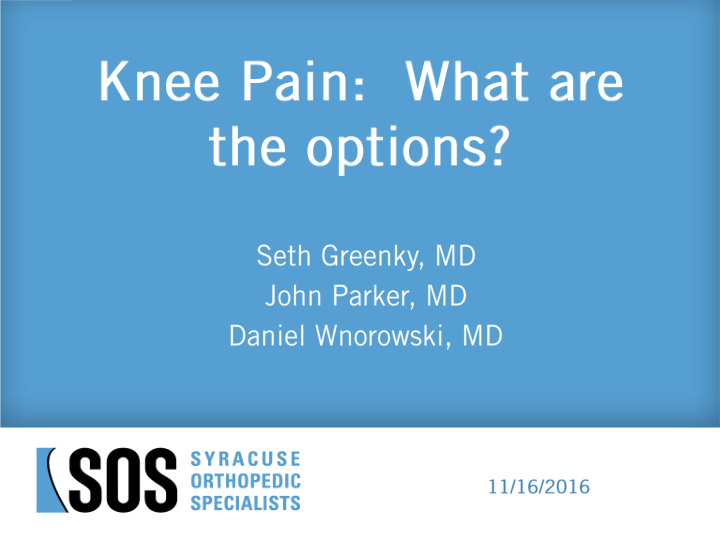



• • •
• Sports related Early-stage: injuries Mild Disease • Minor defects/ loss of cartilage • Increased pain Mid-stage: • Reduced mobility Moderate • Changes to lifestyle/sports activities • Partial knee disease: single or Disease bi-compartmental • Leading cause of disability Late-stage: • Severe pain • Walking, stair Severe climbing Disease challenging • Total knee diseas e
Healthy Knee Medial Osteoarthritis Medial and Lateral Osteoarthritis
Weight Loss anti-inflammatory Changes in activity Surgery is generally reserved for patients whose osteoarthritis is unresponsive to non-surgical treatment
• • • • • •
• – • • • • • • • •
• •
– • • • – – – • • • •
• • – • – • • • •
• • • – – – –
• – – – • •
• – • • • •
•
• – – – – • – • • •
• – – – – • – – • – – –
•
• – – – • • – • • •
Seth S Greenky, MD
Arthroscopy Partial Knee Arthroplasty Total Knee Arthroplasty • Early stage • Early to mid- • Late-stage sports stage osteoarthritis injuries osteoarthritis
Total Knee Replacement • Considered the Gold Standard for advanced OA of the knee • Proven long term survivorship 90% out 15 years • One of the most successful procedures in orthopedic medicine Limitations • Highly invasive • Requires extensive rehabilitation • May remove healthy cartilage and tissue • Duke University study survey reports 88-92% of women and men respectively decline hip and knee total arthroplasty when offered*
Partial Knee Replacement • Only targets diseased portion of the knee • Smaller incision than total knee surgery 1 Limitations • Optimal implant positioning and alignment has historically been challenging • Requires extensive rehabilitation • Less than 52,000 partial knee procedures in the U.S. in 2009, compared to over 600,000 total knee procedures. 2 1 Repicci , JA, et al., “Minimally invasive surgical technique for unicondylar knee arthroplasty,” J South Orthopedic Association, 1999 Spring; 8(1): 20 -7. 2 Millennium Research Group. US Markets for Large-Joint Reconstructive Implants 2012. March 2012
• • •
• •
• • •
•
• •
• • • • • •
• • 6-8% >35% * Willis-Owen et al 2009, Arno et al 2011, Pandit et al 2011, Kozzin & Scott, JBJS 1989, Sculco TP. CORR 2002, Stern et al, CORR 1993
• • • • • – – –
• – – –
• – – – – – –
•
•
An overcorrection in valgus is - associated with an increased risk of degenerative changes in the opposite compartment** Severe under correction in varus is - associated with increased wear in the tibial component and recurrence of the deformity which was indicative of polyethylene wear** * Collier, Matthew, et al., “Patient, Implant, and Alignment Factors Associated With Revision of Medial Compartment Unicondylar Arthroplasty.”, Jour of Arthro, Vol 21 No 6, Suppl. 2, 2006. ** Hernigou, Ph, Deschamps, G., “Alignment Influences Wear in the Knee After Medial Unicompartmental Arthroplasty.”, Clin Orthop Relat Res., Volume 423, June 2004, pp 161 -165.
John Parker, MD
• • • • •
• • •
• • •
•
•
• • 1 Repicci , JA, et al., “Minimally invasive surgical technique for unicondylar knee arthroplasty,” J South Orthopedic Association, 1999 Spring; 8(1): 20-7. 2 Hall et al., “ Unicompartmental Knee Arthroplasty (Alias Uni- Knee): An Overview With Nursing Implications,” Orthopaedic Nursing, 2004; 23(3): 163-171.
Recommend
More recommend